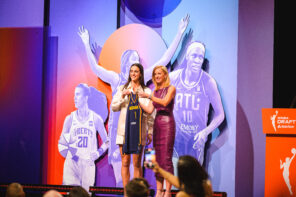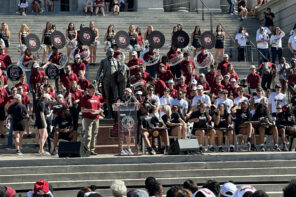There are three lessons in life. You do not spit into the wind, you do not tug on Superman’s cape and you do not try to mansplain women’s sports to those who know its realities – because women’s sports Twitter will clap back at you.
@Money23Green We’re not new to this. We’ve tried that angle many times. So instead of blaming us for the sexist power structure we did not create, how bout you put your money where your mouth is? I can send you an NDA/my pitch deck today. What’s up?!
— Devereaux *casual fan* Peters (@MsPeters14) March 28, 2021
With.
How the WNBA looking at Draymond Green right now pic.twitter.com/VUBtecMx5Z
— Josiah Johnson (@KingJosiah54) March 27, 2021
Thee.
👋🏼 @Money23Green read ur “thread” (@Jack help! 😜) The things ur saying are the EXACT things we’ve been fighting for. We don’t ask for NBA money, we point out the discrepancy to highlight the lack of investment & coverage. You got the problem right, you just tagged the wrong ppl https://t.co/H5wc706BfE
— Sue Bird (@S10Bird) March 29, 2021
Quickness.
…won’t do the same for women’s leagues now. It’s on understanding what’s fundamentally required to grow/increase interest: MONEY, COVERAGE, RESPECT, TIME.
We’d love to have you on board, @Money23Green, but respect the people who have been doing the work. 👍🏻
— Sarah Spain (@SarahSpain) March 27, 2021
Draymond Green learned that the hard way when he sent out a series of tweets – it wasn’t a thread – lamenting why he believes the WNBA lacks interest from the mainstream.
Granted – it was somewhat surprising to see this viewpoint coming from someone who, by all intents and purposes, is among the many allies of the W within the NBA’s ranks. After all, this is the same Draymond Green who once mentioned that he learns fundamentals from watching the W.
He is clearly a good egg who just had a bad take, but let us deconstruct Mr. Draymond Green’s tweets one-by-one…
I’ve been seeing a lot of talk about the pay gap between women and men. Especially in sports. It’s not even close. But let’s stop allowing y’all complaints to fall on deaf ears due to numbers. As long as y’all make the argument about pay, while the revenue stays the same…
— Draymond Green (@Money23Green) March 27, 2021
He acknowledges the pay gap between men’s and women’s sports, which this week got renewed attention in light of the U.S. Men’s Soccer team failing to qualify (again) for the Olympics while the USWNT continue to kick tail and take names.
They will continue to point at the revenue not being high enough to cover bigger salaries. While that is true in damn near every business, how do we take that card out of their pockets? That’s the key to changing the pay. There’s no argument for lack of revenue, unless…
— Draymond Green (@Money23Green) March 27, 2021
This is the beginning of where his tweets begin to go off the rails. Plenty of companies make financial decisions based, not on revenue, but on priority. Or, as David Berri constantly points out, lots of men in high-ranking positions of power make decisions on what to invest in solely because of if it is an investment in men or women. The debacle of the NCAA tournaments told all of us that.
You make those that say they stand for women actually stand up. The NBA wasn’t always the global game that it is today. It wasn’t always driving as much revenue as it does today. But there were people behind it, building the platform, and more importantly telling INDIVIDUAL…
— Draymond Green (@Money23Green) March 27, 2021
He is exactly right here – but this is because there were enough people who believed enough in the NBA that it could become the global juggernaut it is now. They made decisions with their dollars and it paid off. There once was a time when the Finals were on tape delay. Now, it is arguably the most-talked about sport on social media outside of (perhaps) international soccer. Why? Lots of well-monied individuals invested in the NBA and pushed the league to the masses. The investment worked.
stories and building up the interest in the players. That’s how the game took off. Who’s building up y’all platform? Who’s telling the individual stories of how great y’all are? Building the interest and transforming women’s basketball into a global game?
— Draymond Green (@Money23Green) March 27, 2021
When Green here says, “Who?” he is clearly talking about mainstream media outlets. While women’s sports, including the WNBA, are much more deserving of robust coverage than being, as former Swish Appeal editor-in-chief Tamryn Spruill once put it, treated like a booty call, lesser known outlets such as Girls Talk Sports, Winsidr, The Next, Her Hoop Stats, WSlam and us at Beyond The W (along with plenty of others) are filling that vacuum the best we can to tell those stories and amplify these women.
Remember – lots of WNBA scribes are pursuing W journalism and content creation purely as a labor of love because lots of mainstream outlets not named ESPN (Mechelle Voepel), The New York Times (Howard Megdal) and the Associated Press (Doug Feinberg) are not paying top dollar salaries to cover the W. Plenty of WNBA writers and journalists are coming out of their own pockets to cover big events such as the draft, All-Star and playoffs/Finals.
And it is not only the players’ stories that are being told but those of decision-makers such as Keia Clarke, the Liberty’s CEO and influential “Disrupt the Game” agent Allison Galer.
Some may think it’s global because all the women go to overseas and play during the year, but the global response isn’t big enough. Having to go overseas should never be the case but because the stories aren’t told, especially here in the states, y’all hands are forced.
— Draymond Green (@Money23Green) March 27, 2021
This is where the investment issue comes into play again. WNBA players go overseas after the season because they are paid much more robustly by the UMMC Ekaterinburgs of the world they are by the Seattle Storm’s, Washington Mystics’ and New York Liberty’s of the world. WNBA players addressed this in the CBA that was struck at the beginning of 2020 before the pandemic hit.
With the W being part of the overall NBA family, if more NBA players and executives stood up and upped their investments in the W, then more players would not have to go overseas and would have more time to stay in the States (or in the case of Kia Nurse, Natalie Achonwa, Bridget Carleton and Kayla Alexander, Canada) and more of those stories could be told year round by mainstream outlets.
Granted, it is admirable that many WNBA players such as Chiney Ogwumike and Candace Parker have found other lucrative opportunities that enable them to stay in the USA more. But most W ballers do not go overseas because they want to – but because they have to. More robust investment (like the NBA got) can change things – and with Green being one of the NBA’s premier ballers, he can have lots of sway on how things work at Park Avenue.
I’ve been asked to do so many PSAs this month on women empowerment. I said no. It’s hypocritical. Because these same companies that are telling women empowerment are not putting their money where their mouth is. Call on this companies to support y’all. To infuse capitol into…
— Draymond Green (@Money23Green) March 27, 2021
He makes an interesting point here. Especially nowadays in the age of Me Too and Black Lives Matter, it is considered good public relations to be seen as a company that is either pro-women or pro-Brown, pro-Asian or pro-Black. But how many of these companies will sport a Black Rosie every March, but donate political dollars to anti-woman or anti-Black interests?
Looking at you, Delta. Looking at you, Coca-Cola. Looking at you, Home Depot.
The business. Stop allowing them to yell women empowerment for the look. No company grows without funding. Y’all business can grow with the proper funding and story telling. Make these huge companies commit money to y’all cause. That’s empowering! Or don’t yell women empowerment
— Draymond Green (@Money23Green) March 27, 2021
And you know which organization can really be at the forefront of this? A little known organization we believe is called….the National Basketball Association, which we believe you are part of.
I can go on and on but would love to help drive these discussions with y’all. Lastly, if the goal is to become as big as the NBA, you have to push NBA like things. DT said Paige is the best player in basketball already. Why is there no discussion about her leaving this year?
— Draymond Green (@Money23Green) March 27, 2021
No discussion? He follows WNBA accounts and knows WNBA players, but does he follow WNBA media people like Khristina Williams, Ari Chambers and even Feinberg? The discussion on Paige Bueckers (as well as Caitlin Clark) prior to the much-ballyhooed Sweet 16 NCAA tournament contest between UConn and Iowa has produced a discussion on if freshmen should be allowed to enter the draft.
After all, we know just by looking at how the NBA side works that college is not for everyone. LeBron James was drafted out of high school No. 1 overall by the Cleveland Cavaliers with the first pick in the 2003 NBA draft.
We heard he has had a pretty decent career ever since.
Also…”Paige”? Whenever a player reaches first-name only status (see: Sabrina), that lets you know that player has already reached superstar status or is on the cusp of such. The question we have is when she finally does became draft eligible if WNBA teams will tank to draft her No. 1 overall.
Well a huge part of that is because the payoff isn’t as big. It’s not the norm. How do you change the norm and y’all keep doing the same thing? All these companies yelling women empowerment can easily endorse Paige to make up for the lack of payment in y’all league.
— Draymond Green (@Money23Green) March 27, 2021
Archaic rules about NCAA player endorsements, the inability to capitalize off of one’s name and likeness aside (as well as those about WNBA draft eligibility requirements), our guess is that when Bueckers leaves UConn for the W, she will have a shoe deal (or deals) waiting for her the nanosecond she declares.
They can easily tell y’all stories. But they don’t have to because the request that are being made are falling on deaf ears because y’all keep saying pay me more, with no way to drive the revenue. Force hands! Paige number#1 pick 2021!
— Draymond Green (@Money23Green) March 27, 2021
Again – the solution is twofold. First, encourage NBA executives with “more zeroes,” as Aces coach Bill Laimbeer once put it, to invest more money into the WNBA. Second, amplify the voices of the lesser-known outlets that are already telling these stories and force the hand of larger, more established outlets that they need to get with the program and invest real dollars into covering women’s sports.
Break the mold and change the game! Most importantly, change the BUSINESS. Call on these companies for support, after all they are using y’all to push WOMEN EMPOWERMENT , but not helping y’all. They’re simply saving face.
— Draymond Green (@Money23Green) March 27, 2021
We are working on it – very, very diligently.
See you soon.
— Beyond The W (@BeyondTheW) March 24, 2021




